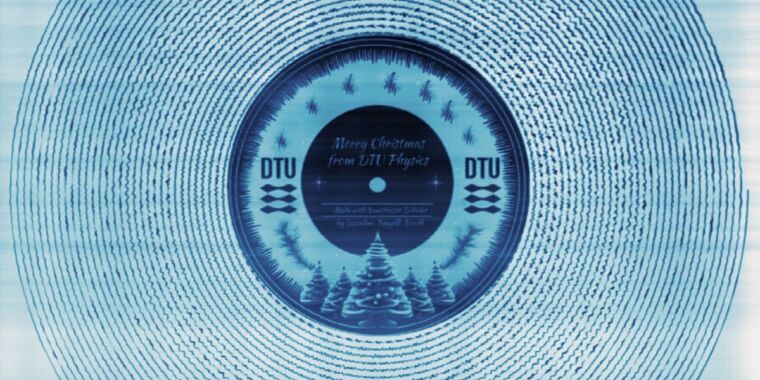The first 25 seconds of a classic Christmas carol were engraved in polymer film using the Nanofrazor 3D lithography system.
Physicists at the Technical University of Denmark (DTU) are bringing Christmas cheer by using a 3D nanolithography tool called the Nanofrazor to create the smallest record ever. The tune they ‘recorded’, no less in full stereo: the first 25 seconds of ‘Rocking Around the Christmas Tree’.
“I’ve been doing lithography for 30 years and even though we’ve had this machine for a while, it still feels like science fiction,” says Peter Bøggild, a physicist at DTU. “To get a sense of the scale we’re working on, we can use this thing to write our signature on a red blood cell. The most radical thing is that we can create free-form 3D landscapes with that insane resolution.”
In 2015, the same DTU group took a microscopic color image of the Mona Lisa, some 10,000 times smaller than Leonardo da Vinci’s original painting. To do this, they created a nanoscale surface structure consisting of rows of columns, covered with a 20 nm thick layer of aluminium. How much a column was distorted determined which colors of light were reflected, and the distortion was in turn determined by the intensity of the pulsed laser beam. For example, low-intensity pulses distorted the columns only slightly, producing blue and purple hues, while strong pulses significantly distorted the columns, producing orange and yellow hues. The resulting image fits into a space smaller than the footprint occupied by a single pixel on an iPhone Retina display.
DTU Physics
The DTU physics group acquired the Nanofrazor to quickly and relatively cheaply accurately model detailed 3D nanostructures. The Christmas plate was just a fun holiday project for postdoc Nolan Lassaline to demonstrate how to form a surface with nanoscale precision. Instead of adding material to a surface, the Nanofrazor precisely removes material to sculpt the surface into the desired pattern or shape – a kind of grayscale nanolithography.
“The Nanofrazor was put to work as a record cutting lathe – converting an audio signal into a spiral groove on the surface of the medium,” says Bøggild, who is also an amateur musician and vinyl record enthusiast. “In this case, the medium is a polymer other than vinyl. We even encoded the music in stereo – the lateral squiggles is the left channel, while the depth modulation contains the right channel. It may be too impractical and expensive to to get hit To read the groove you need a rather expensive atomic force microscope or the Nanofrazor, but it is certainly doable.”
The original goal is to use the Nanofrazor to develop new types of magnetic sensors that can detect the currents in living brains. Lassaline plans to create “quantum bubbles” in graphene in hopes of discovering new ways to precisely manipulate the electrons in that and other atomically thin materials. “The fact that we can now accurately shape the surfaces with nanoscale precision at virtually the speed of the imagination is a game changer for us,” said DTU physicist Tim Booth. “We have a lot of ideas for what to do next and believe this machine will significantly speed up the prototyping of new structures.”

